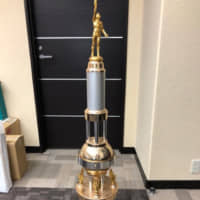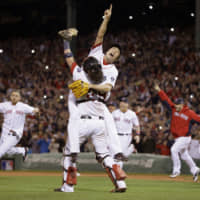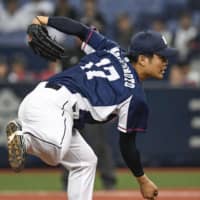It’s raining hard at Shinbanba station in Tokyo’s Shinagawa Ward. Pouring, actually, real cats-and-dogs-type stuff.
Sac Bunts is here, on the Keikyu Line platform, with Marty Kuehnert, former general manager of NPB’s Tohoku Rakuten Golden Eagles and currently a senior GM with the B. League’s Sendai 89ers, and Mark Schreiber, a frequent contributor to The Japan Times. Schreiber is the leader of this little excursion into a story involving baseball legend Sadaharu Oh and a sick child.
“You picked a great day,” Kuehnert jokes.
Eventually the rain abates, the sun appears and we’re off. From Shinbanba station, we take two rights and then walk along the Meguro river to the entrance of Kaitokuji temple.
A path of uneven stones leads into the grounds, and at the far end, to the left of the main building, is what we’re looking for, the “Kazuo Jizo,” or as many call it, the “Home Run Jizo.”
Jizo are small stone statues, usually depicting bald monks, that are said to be guardian deities for children and travelers. They’re often found along roads and around temples, sometimes dressed in red bibs and caps.
What sets this one apart is the monk, sitting cross-legged, is clutching a baseball bat in his right hand and holding a ball in his left palm. There are various coins, left behind by other visitors, in his lap. While jizo can come in different forms, there may not be too many that look ready to play nine innings.
The story behind this statue revolves around Oh and Kazuo Iwasaki, the boy whose gravesite the jizo rests upon. It’s told in the Kaitokuji Bulletin No. 13, which was given to us at the temple (and translated by Schreiber), which also features a picture of the pair.
Iwasaki, born May 9, 1948, had been a normal boy who liked to play sports. He fell ill in February of 1959, and doctors discovered he was suffering from an enlarged heart. He was then hospitalized at National No. 2 Hospital in Komazawa, in Tokyo’s Setagaya Ward.
Oh had signed with the Yomiuri Giants, as a pitcher, that year. He stopped by the hospital in March of 1959, with the Giants nearby to play against the Toei Flyers at Komazawa Stadium, and was approached by Iwasaki’s mother, Masako, who had wanted his autograph. After hearing about Kazuo, Oh did her one better and went to meet him, which was a huge delight for the boy. The pair bonded, and Oh would visit when the Giants were playing nearby.
But Iwasaki didn’t get better and was sent home in 1961. His condition worsened later that year and, with help from Oh, he was admitted into the Keio University Hospital in December.
Oh remained in contact and sent the family a New Year’s greeting the following month.
“Happy New Year. I had no time last year so I apologize for not coming to visit,” it said, according to bulletin. “Please get well as soon as you can and make your parents and I happy. I mean it. This year I’m going to give my best too.”
Oh saw Iwasaki, whose condition was getting worse, again on Jan. 26, before leaving for spring camp. It was said the visit really lifted the boy’s spirits. Sadly, Kazuo passed away the next day at age 13.
Oh, who had by then switched from pitcher to position player, led the Central League in home runs for the first time that year (he’d also win the home run title in each of the next 12 years and twice more after that streak was snapped), hitting 38.
After the season, Oh visited Iwasaki’s grave, where the statue had been placed, and reported his accomplishment. He did the same after other milestones. Eventually, the statue was given the nickname “Home Run Jizo.”
While the story of Iwasaki and Oh didn’t exactly have a happy ending, the bat and ball the statue can be seen holding suggest Oh brought some light into Kazuo’s life.
Oh has long been known for his generosity with fans as well as his baseball achievements, including his record 868 home runs. In Shinagawa, those worlds are brought together by a small statue that’s still watcheing over one of his biggest fans.
Source : Baseball – The Japan Times


